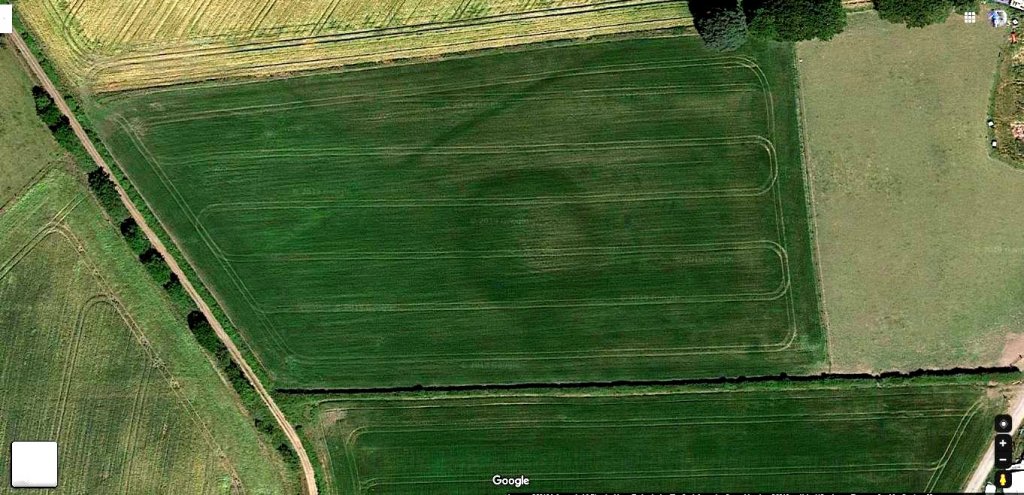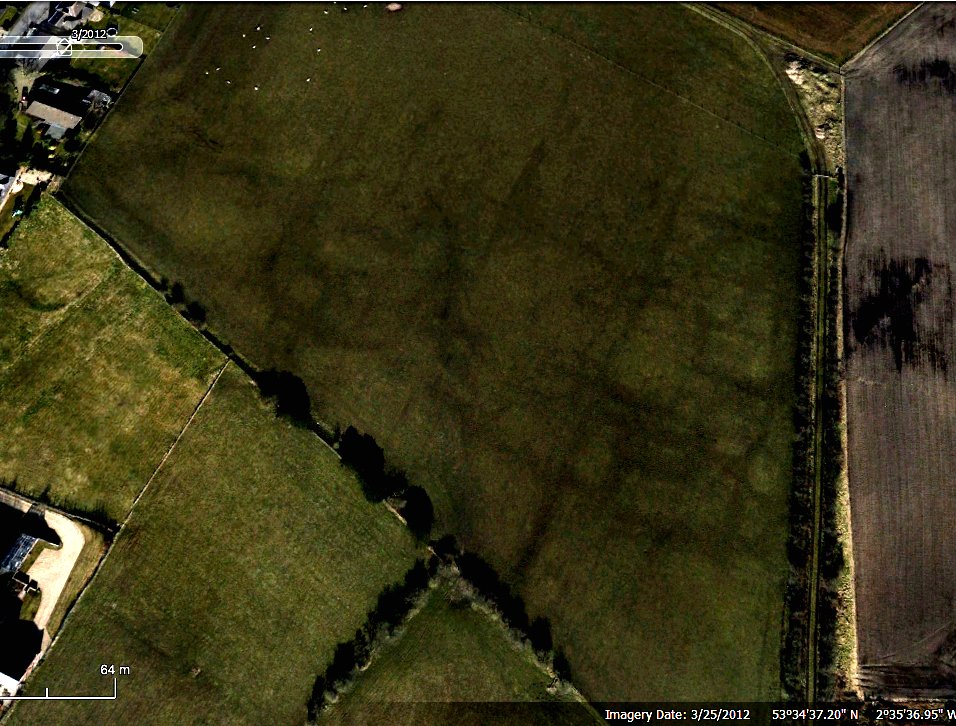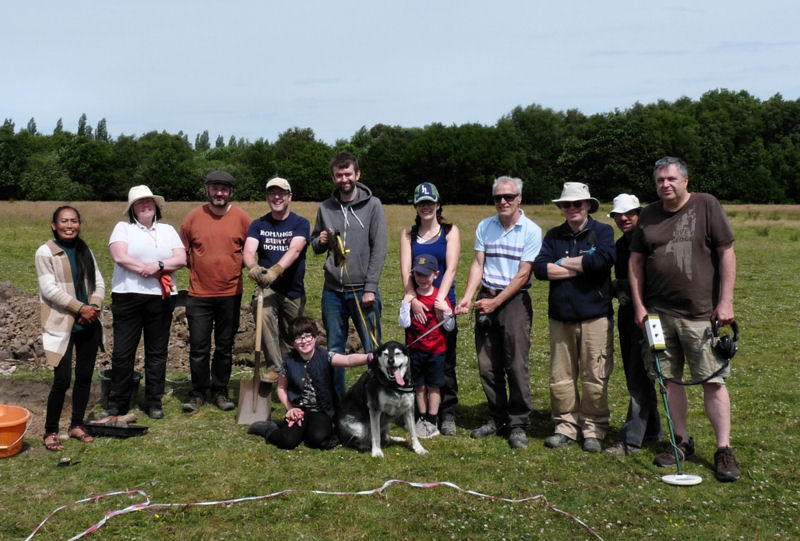We first became aware of this feature when Steven Twigg (formally of STAG – South Trafford Archaeology Group) contacted us with an aerial image in 2019. The crop mark shows up quite clearly as a dark green circle and seems to represent a circular ditch around 40m in diameter. Viewing various other aerial images spanning a number of years confirmed the mark to be more than just a temporary agricultural feature.
 The size of the circle would suggest something prehistoric and probably older than Iron Age as it is certainly bigger than a roundhouse. The LiDAR image however revealed the site to have a shallow mound in the centre. This would suggest a Bronze Age barrow (similar sized ones can be seen at Normanton Down in Wiltshire). Its central mound and continuous surrounding ditch would suggest a Type 2 Bowl Barrow as classified by Historic England. (ref)
The size of the circle would suggest something prehistoric and probably older than Iron Age as it is certainly bigger than a roundhouse. The LiDAR image however revealed the site to have a shallow mound in the centre. This would suggest a Bronze Age barrow (similar sized ones can be seen at Normanton Down in Wiltshire). Its central mound and continuous surrounding ditch would suggest a Type 2 Bowl Barrow as classified by Historic England. (ref)
In the Autumn of 2021, we carried out a resistivity survey of the site with very encouraging results as reported in our October Newsletter (No.246). This year we’ve been able to return to carry out further investigations and start a season of excavations. You can find more details of our Aspull Ring Ditch project here
– and follow our the progress with our Site Diary blog here
Category Archives: Site Visits
Aspull DMV Survey
In February 2020 our attention was drawn to crop marks appearing on earlier versions Google Earth in a field in Aspull. They only appear in 2012 and 2013 but as they span over 12 months it suggests they are likely to represented something more than just agricultural activity. What is interesting about the rectilinear shapes of the crop marks is that they have all the hallmarks of a DMV (i.e. a Deserted Medieval Village). A circular feature on the left side of the field could be even be prehistoric.  DMV sites can be found all over the country although few occur in the northwest (the nearest examples is perhaps at Tatton Park in Cheshire). Their dates can range across the whole of the early Medieval period although they are usually the result of either the plague or clearance by the lord of the manor to create a park (as was the case at Tatton).
DMV sites can be found all over the country although few occur in the northwest (the nearest examples is perhaps at Tatton Park in Cheshire). Their dates can range across the whole of the early Medieval period although they are usually the result of either the plague or clearance by the lord of the manor to create a park (as was the case at Tatton).
Corvid has effected or field operations but lockdown restrictions are beginning to ease so, being eager to get back into the field, we started our survey of the site earlier this month. You can find out how we got on here.
Douglas River Source Trip
As part of the Douglas River Project, last month Eric and I met at Rivington Barn for a trip onto Rivington moor. This was to see if we could trace the route of the River on the moor and perhaps find its source (clues where to look are in the name i.e. Douglas Springs). Having climbed up through the terraces of Lord Leverhulme’s Japanese garden onto Belmont Road, we soon had our first encounter with the River – little more than a stream at this point, it passes through a culvert under the road at a place called Brown Hill. You can find details of the rest of the trip here.
St Wilfrid’s Ledger Stones Survey
Following on from our Graffiti Survey last year in the Parish Church at Standish, it has been our intention to record the grave slabs (ledger stones) inside the church. These were exposed when the carpets were removed last year. These ledger stones have not seen the light of day in a good many years and we thought it would be a shame for them disappear again without being properly recorded. You can follow our progress here.
Trip to Bolton Museum and Holcombe Moor
It’s great to have a member of your Society who is also the curator of a nationally important museum so Trumble’s guided tour around Bolton’s Egyptian Galleries last Sunday was bound to be top class. Our trip out to Neil Coldrick’s excavations on Holcombe Moor was also a very enjoyable experience – view all the details here
GM Festival of Archaeology 2019 (Toddington Lane Well Site)
Another great festival weekend with eleven bodies on our site at Toddingtons on Saturday and a further nine on Sunday – including a total of seven members of the general public. We also had a good number of visitors stopping by over the two days inquiring about our activity on our Well Site, which is on the west side of Toddington Lane at Haigh. 
We were looking for the old well marked on the 1849 OS but not on any later maps, and also evidence of the possible Roman road linking Wigan with Ribchester. You can follow our activities on our site diary here.
Trip to Vindolanda, Chesters and Binchester
Despite the small turnout the trip was very enjoyable and we got to see quite a lot. The idea was to have a long distance trip similar to last year’s successful Orkney trip and Vindolanda, and the forts on Hadrian’s, seemed to be a suitable subject. You can follow the weekend event here
Trip to Ribchester, Whalley Abbey and Bleasdale Circle
Great turn out for our summer trip this year which everybody body seemed to enjoy (helped no doubt in part by the fine weather. You can see all the details about it here
GM Festival of Archaeology (& Brimelow Farm Open Day)
The weekend Festival and Open Day was a great success with a good number of volunteers and many visitors over the two-day event. Friday volunteer numbers were down (probably as it’s a weekday) but, on Saturday, we were oversubscribed.

Saturday’s volunteers and crew. Left to right: Chon, Tracey, Al, Darren, Alex, Vanessa, Bill, Patrick, Andy and Mark. Front row: Lily, Indiana (Bones) the dog and Lucas.
Throughout the two days we had a constant stream of visitors, particularly from the local residence who were keen to have a look at the Roman road we had discovered on their door step (encourage to have a look by Trevor acting as gatekeeper). It was particularly pleasing to see David Ratledge who hasn’t been too well recently – his Gazetteer of Roman Roads in Lancashire is quite comprehensive (and he’s currently working on roads in Cheshire – we all wish him well on this project).
Much Progress was made on searching for the Roman road between Wigan and Walton-le-Dale and you can see the details of our work here.
Norton Priory Trip
Great day out last Saturday despite the reduced numbers. It was the open day for the archaeological excavations which are being run by Liverpool University as training site undergraduates. More details here

